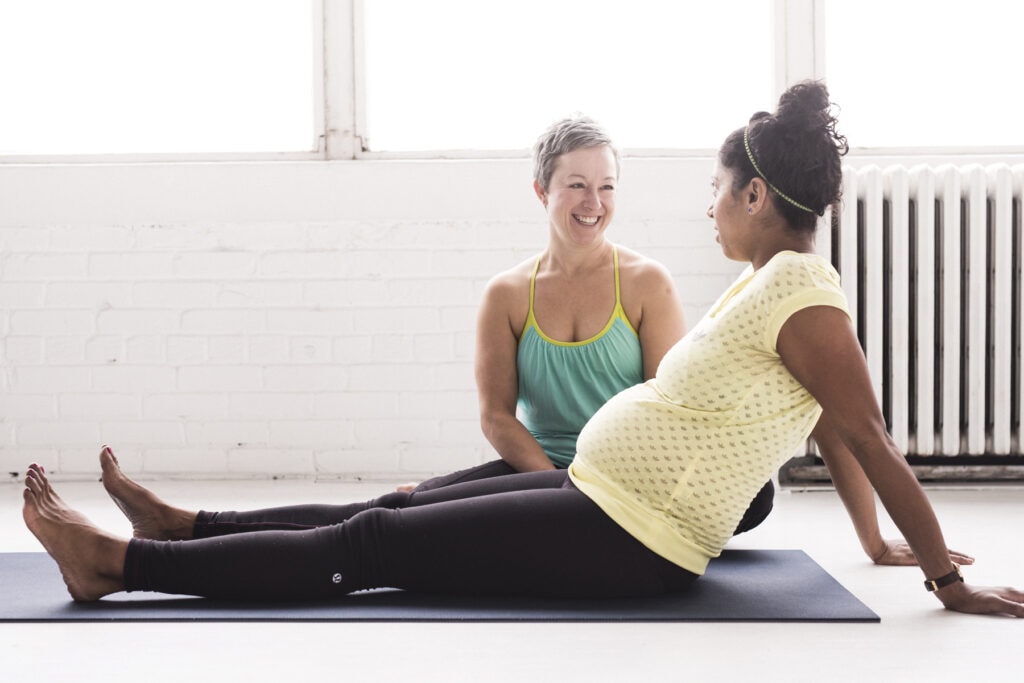Recently, we hung out with some old friends and had an awesome night filled with laughs, a campfire, and listening to some great old songs that came out when we were all around 22.
It was super fun. But at a certain point the ladies had a conversation. Turns out, all three of us have experienced pelvic floor problems. That really got me thinking.
Because isn’t it nuts that three out of three women in the group, have had pelvic floor issues!??!!? That’s not normal!
Turns out it’s pretty darned common though.
100% of a fairly random sample are already having problems with our pelvic floors. Sneeze pee, workout pee, that kind of stuff. The kind of stuff that is annoying at 40 and that turns into diapers and surgery at 70.
I already knew that pelvic floor issues are incredibly widespread. But somehow it really came home to me that night.
I’m really lucky and grateful that I found the world of movement when I did, because my pelvic floor is now pretty much 100% functional.
It makes me sad that many of my friends – and many, many other women – struggle with this. When it’s totally fixable.
So this post is for you, my friends. And for any other person who wants to know how to fix their pelvic floor, right now.
So, What Exactly Is A Pelvic Floor Issue?
When things aren’t in good shape down there, you could notice any of the following problems
✅ Pelvic pain and/or painful sex
✅ A feeling of heaviness or pressure in the pelvis
✅ Unusual bleeding
✅ Constipation
✅ Incontinence, including sneeze pee, laughter pee, workout pee, running pee, urgent need to pee, fecal incontinence.
✅ Or even an organ protruding from your vagina or rectum
✅ Back pain
✅ Hip pain
✅ And for men, erectile dysfunction, pelvic pain, and prostate issues.
Often pelvic floor issues go hand in hand with abdominal issues like hernias, low back pain or a diastasis recti because they have similar causes.
So pelvic floor issues basically suck, and like any movement-related issue, if you don’t work on them, they’ll often stick around or get worse.
But the good news is that there’s SO much you can do to fix them, a lot of which is free or restively inexpensive.
And it works – I’m living proof.
I used to totally pee when I sneezed, ran or worked out and didn’t even know it was a sign something was wrong. Now, I’m 100% fixed.
Start healing your pelvic floor, building a functional core & caring for your spine (for free!)
The Problem With Your Pelvic Floor
Why isn’t your pelvic floor working?
Although you might think it’s because you had kids, that’s probably not the whole reason. In fact, many people without kids have pelvic floor issues.
The entire function of the female pelvic floor is to bear children. And also to bear the weight of your organs, and allow you to eliminate, and it’s definitely not supposed to fail just because it’s doing any of its jobs.
So, what went wrong?
Basically, everything modern humans do is crap for your pelvic floor.
Your pelvic floor muscles are supposed to be at the perfect length & strength so they can shorten and tighten when they need to keep stuff inside (like your organs and your pee), and loosen and lengthen when things need to get out (like babies and pee).
But for most people, for most of our lives, all the movement (or lack of movement) we have done has made those muscles get short. A short muscle is a weak muscle – it doesn’t have the ability to generate force the way it should.
Habits That Shorten (and Weaken) Your Pelvic Floor
Here’s some stuff that makes pelvic floor muscles get short. And weak.
👉 Sitting
👉 Biking or spinning
👉 Stress
👉 Wearing shoes with any amount of heel rise
👉 Standing with our pelvis way out forward
👉 Holding tension in the pelvic floor
👉 Not walking much
👉 Not squatting much
👉 Not using our hips much
👉 Doing lots of Kegels by focusing on the tightening action
If any or all of those describe you, you’re at risk for pelvic floor issues.
Things That Overload Your Pelvic Floor
A short weak pelvic floor might still work fine until it gets OVERLOADED. That means that it’s being asked to deal with more than it can handle, and it fails, hurts or gets damaged.
What might overload a weak pelvic floor?
Here’s what:
👉 Jogging
👉 Jumping around (trampoline, CrossFit)
👉 Having a baby
👉 Constant belly breathing
👉 Straining on the toilet
👉 Laughing
👉 Coughing
👉 Sneezing
You’re probably getting the sense that pelvic floor issues might be really common in our sitting-a-lot-wearing-heels-not-walking-or-squatting-much-but-doing-lots-of-Kegels culture – and, my friend, you’re right.
A ridiculously high percentage of North American women get pelvic floor stuff. 40%-50% by the time we hit 60. NOT COOL.
Men get pelvic floor stuff too, but they don’t usually talk about it much. Pelvic pain, erectile dysfunction, urinary problems and prostate stuff, all pelvic floor related, gentlemen.
Here’s How To Fix Your Pelvic Floor
I’m going to give you a whole bunch of ideas here.
If you try to do them all at once, it might be a bit much. Most of us succeed best when we make small changes over time instead of trying to do it all as once.
Sooooo, I’d suggest that you spend a bit of time working through each step, researching it, and making a few changes at a time.
Pick the stuff that you can do most easily first, because that way you win faster.
Remember that doing ANYTHING counts. You may not get totally fixed if you don’t do much, but in the long run, it’ll help.
And I’ll be honest with you: body changes like this can take time, so be patient. You’ve taken a lifetime to develop this issue, it might take more than a week (or a month, or a year) to fix, but you’ll get there if you work at it.
So stick with it, work as much as you can, and then email me to tell me what you’ve noticed because I’m pretty sure that you’ll get some amazing results!
Step One: Stop Doing Stuff That Makes Your Pelvic Floor Short & Tight.
Sit Better
If you have to sit in a chair, learn how to sit with a neutral pelvis.
Use Chairs & Sofas Less
Stop sitting in chairs all the time! Stand more and sit on the floor more instead.
Get some floor sitting inspiration here!
Sitting with your hips and knees at 90 degree angles (like in a chair), tells your body to shorten your pelvic floor. It also creates adaptations that make your walking and squatting work less helpful for your body.
When you rest on the floor (or really on a bolster or cushion) instead of a chair, you give your body new and different signals. It starts to adapt to the greater variety and movement. As a result, you get big shots of goodness to your pelvic floor muscles. It also naturally makes your walking and squatting better for your body.
Simple stuff like sitting cross-legged or in a vee-sit when you watch TV can really make a difference to your hips and your pelvic floor!
Another huge benefit of floor-sitting is that you get a mini-workout many times a day. The work of lifting and lowering your body weight is more than you might realize. Due to this, floor sitting will do a lot to keep you strong, functional and mobile, with no extra time added to your day!
Here’s how to sit well on the floor.
Stop Wearing Shoes With Heels.
I know. We all love pretty shoes. For most of us that’s shoes with heels. And even if you want minimal shoes, they can be hard to find. And sometimes extra not pretty.
But three things.
First, we, as women, need to start asking for shoes that do not cause serious and lasting harm to our bodies. Until then there won’t be many pretty yet healthy shoes. The more the merrier at this party!
Second, it’s funny how your tastes change. Since I switched to minimal shoes, I no longer see anything pretty about women wearing high heels. I mean, the person herself may be lovely. But, I find that the heels make them look awkward and strange. You may end up discovering that shoes that great actually can look great!
Third, it’s not really that hard to find good options. Harder than going to the mall. But we’re smart and capable and isn’t fixing your pelvic floor worth a bit of work?
Here’s a blog post I wrote with lots of resources and tips for switching to minimal shoes. Which your pelvic floor will LOVE. The rest of your body probably will too.
ALSO – remember – just because your shoe isn’t a ‘high heel’ doesn’t mean it doesn’t have a high heel! For instance, running shoes have a raised heel. Any amount of lift at the heel is a problem.
Stop Standing With Your Pelvis Way Out In Front Of You.
Here’s how to move your hips back. This one’s really important, and you can practice ALL THE TIME.
Stop Biking, Spinning, And Walking On Treadmills. Maybe Running Too.
There’s nothing terrible about any of these activities, but they aren’t helping your pelvic floor.
Biking, spinning, and treadmill walking are all butt-free activities. But, to fix your pelvic floor, you’re going to need your butt. Instead, pick walking outdoors (in nature if possible) as your fitness activity until things are super functional again, or maybe forever!
Running may or may not require your butt. But if you’re already experiencing pelvic floor issues, it could be a lot of overloading when you run. As a result, it might be a good idea to walk more right now instead.
Stop Straining On The Toilet.
Did you know that lots of heart attacks happen on the toilet because of all that pressure? Imagine what it’s doing to your pelvic floor! Can you say giant overload?!?!
Consider adding more fibre to your diet (hello, chia pudding!!) and perhaps hydrating more. Using a Squatty Potty or similar bathroom stool can also be very helpful.
Stop Doing Kegels (Unless You’re Working With A Really Good Pelvic Floor Physio).
There’s a place for Kegels. Maybe.
But for most of us, the issue with our pelvic floor is that it’s short and tight and weak. Due to this, a Kegel that squeezes and tightens your pelvic floor isn’t usually very helpful. (Click here to read more about “Why Kegels Aren’t Helping Your Pelvic Floor (And What To Do Instead)”).
A good physio will be able to help you do a Kegel where you learn to RELAX those muscles as well as tighten them. If they even give you Kegels at all. But for most of us, spending time enthusiastically squeezing everything down there is probably not helpful and may be harmful.
Step Two: Start Doing Stuff That Lengthens, Relaxes And Strengthens Your Pelvic Floor Muscles.
Create stronger and more functional pelvic floor that can handle the loads of every day life.
Make More Time To Relax.
Your pelvic floor is incredibly responsive to stress and anxiety. So are related muscles called the psoas muscles that really affect your core and pelvic floor.
More stress = more tightness = less strength and resilience. You, my friend, probably need to relax more, because modern life is extremely stressful for humans. Even just living in a big city is intensely stressful for your biology.
There are lots of ways to relax. Three of my faves are:
#1 Go for a walk. Relaxing and great movement! Bonus points if there’s lots of green around you, double bonus if you’re fully in nature.
#2 Have a nice bath. Maybe with epsom salts and lavender, because you should enjoy every second of it!
#3 Do this psoas release exercise for 5-10 minutes. It’s also an excellent daily practice – great before bed. FYI, it might not feel like much is happening – that’s ok. You’re learning to relax here, not getting ready to compete in the Crossfit games 🙂 This is one of my top 3 exercises for all humans, btw. If I had to pick.
Walk More To Naturally Lengthen Your Pelvic Floor.
Walking!
Walking is one of the best pelvic floor exercises. Maybe THE best pelvic floor exercise.
Any walking is better than none, but here’s how to make it better for your pelvic floor:
🚶♀️Try walking on hills
🚶♀️Choose natural surfaces as much as you can (even in the city)
🚶♀️Go barefoot or in minimal shoes (make sure to transition to them)
🚶♀️Walk with a friend (I think this is fun and motivating, not sure if it will specifically help your PF, but who knows!? Bodies are complex and humans flourish with community)
🚶♀️Carry some stuff with you, using multiple holds such as in front, on each shoulder, on your head – where else can you think of?
🚶♀️Learn how to walk better
Make Squatting A Regular Part Of Your Life.
Squatting is required for a happy pelvic floor, but maybe not squatting like you think of it at the gym.
Many of us have lost the ability to do a functional, pelvic floor-enhancing squat (all that sitting!) I’m talking about a squat that uses your butt and your hips, and is more like a movement you do as part of your regular life. Plus if you’re already dealing with a pelvic floor issue, you might find that full squats can actually overload your pelvic floor.
The good news is that there are lots of ways to gently introduce the benefits of squatting into your life. Simply preparing your body to squat gives you many of the benefits. Plus eventually you’ll be able to squat! (Need help? Check out my post “I Want To Be Able To Squat – How Do I Start?”).
Another good place to start is by practicing the exercises in these two classic posts by Katy Bowman: You Don’t Know Squat and You Still Don’t Know Squat.
Change How You Breathe
Belly breathing puts a lot of pressure onto your pelvic floor. Which can overload it!
Learning to breath by expanding your ribs instead of your belly is a key way to improve the situation down there. Here’s how to practice rib breathing.
You don’t have to worry about rib breathing all the time. But, the more you practice it, the more you will create a supple, mobile rib cage. Then it will naturally participate more in your breathing. Which means naturally less pressure on your pelvic floor.
Do Some Pelvic Floor-Friendly Exercises Every Day.
The exercises that I teach not only help you learn to move better, they are all generally geared towards creating whole body wellness.
Your pelvic floor is basically ground-zero for movement-related damage.
For instance, there is a strong possibility that if you’re not moving your shoulders enough, your pelvic floor is going to be impacted (due to the fact that shoulders tightness affects your breathing and your core).
And likewise, that if you’re not moving your feet enough, your pelvic floor is going to suffer (because your feet affect your walking and your hips).
I could go on. But the general idea is this: YOUR PARTS ARE ALL CONNECTED.
Working on all your parts is usually going to end up being more helpful than only trying to do the ‘top 3 pelvic floor exercises’ or whatever. It doesn’t have to be overwhelming. Here are some ways to get some really beneficial exercises without them taking over your entire life.
#1 I’ve given you links to a lot of exercises in this post. You could make a list and just work on 1-3 of them every day.
#2 I have a YouTube channel where I regularly post great exercises and tips. Follow me there for lots of ideas.
#2 Get any book by Katy Bowman and work on 3-5 of her exercises every day. Move Your DNA is a great one with lots of pelvic floor goodness, but so is Diastasis Recti and Whole Body Barefoot. Any of them are good options.
#3 Sign up for my Pelvic Floor+ program and learn to move better so your pelvic floor and whole body are happier and healthier!
#4 Check out the Nutritious Movement virtual store and work through the Healthy Pelvis download, the Alignment Snacks or any of the other classes offered there.
Let Go Of Tension In Your Pelvic Floor
Simply unclenching your butt can be a game changer.
If you happen to be a butt clencher, which many of us are.
You might not even know if you are butt clencher!
Often we can be a bit disconnected from our bodies. Often, it takes time and practice to be able to notice tension, and more practice to learn to release it. Plus, the way we stand can create hidden butt clenching – that’s a big reason that moving your hips back is so important.
Try some gentle self-massage of your pelvic floor (and yes, I know how that sounds, but I really do mean massage) by using Yoga Tune Up Balls. You can use an old tennis ball too, but I much prefer the YTU balls if you can afford them.
Be gentle, back off if it hurts, and use it as an opportunity to be kind to yourself.
Here’s one self-release option you can try – I’d recommend starting by sitting on a softer surface such as a folded blanket before you try a harder one.
in Jill Miller’s book, The Roll Model Method, you’ll find lots of techniques for rolling the hips, belly, lower back and the pelvic floor itself – it’s a great resource and I definitely recommend it.
Consider Seeing A Pelvic Floor Physio
If you’re in a lot of pain or have a prolapse, a good pelvic floor PT can be a really good idea. Even if your pelvic floor issues aren’t that serious, it can still be a good idea.
A pelvic floor physio will typically provide manual, internal and external therapy work that can be extremely helpful. They often will also teach you to do exercises that are targeted to your unique pelvic floor and body.
That said, I personally have resolved my pelvic floor stuff without any physio work. And I believe that it’s really important to address the whole body movement part. Seeing a physio but still sitting all the time and wearing high heels is not likely to give you the long term results that you want.
So That’s Basically How You Fix Your Pelvic Floor
Everyone’s body and life is unique. But you can absolutely fix your pelvic floor issues if you try. Remember to not get overwhelmed. Start with small easy wins. Stay committed. And be kind to yourself.
Sign up for my free Ribcage Magic video series and take the first step toward helping your pelvic floor TODAY!







